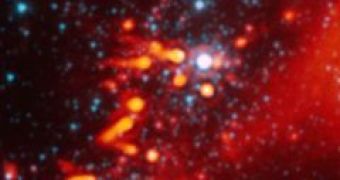It appears that dangerous neighborhoods are not only a problem down here, on Earth, but instead cosmic bodies face such difficulties as well. NASA's Spitzer Space Telescope, seeing in infrared, has managed to capture an interesting phenomenon going on near a group of large stars. The image depicts an apocalyptic view, and shows the effect they have on the planet-forming material of some smaller, Sun-sized stars.
The outer space's "Bronx" is situated some 6,500 light-years away from the Earth, in the constellation of Cassiopeia. It is, in fact, a part of the W5 dynamic star-spawning nebula, home to four brawling giant stars, each about 20 times more massive than the Sun, which rip off three younger, Sun-like stars, located approximately one light year far, of their planet-forming materials, with the help of intense radiation and powerful winds.
"We are seeing the effects that massive stars have on smaller stars that are trying to form planets," shared Xavier Koenig, the main author of a paper on the finding, as cited by PhysOrg. "These stars may or may not go on to form small, inner planets like the Earth, but it's probable that outer planets like Uranus and Neptune would never come to be," said the researcher. "On astronomical timescales, these events are probably fairly short-lived," he added. "It probably takes about one million years for the disks to completely disappear."
And the comparison to humans can be taken even further, as many of the new-born stars manage to cope and survive in this harsh environment, in the vicinity of the behemoth stars. According to some scientists, even our own Sun was such a troubled star, once lying in a huge star-forming cloud. But as time passed, it dispersed, together with other stars, and traveled far from their place of origin, living in solitude ever since and nursing their planetary systems.

 14 DAY TRIAL //
14 DAY TRIAL //